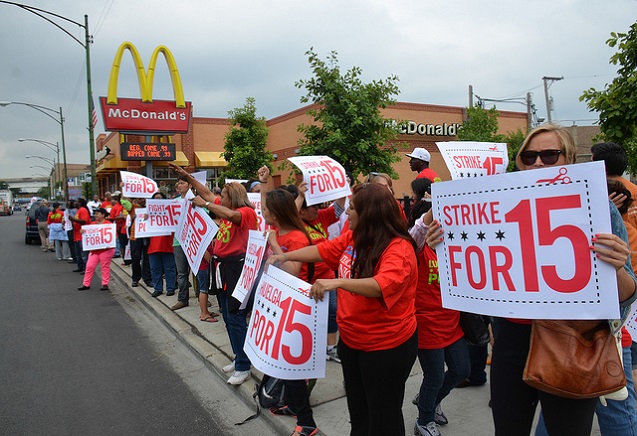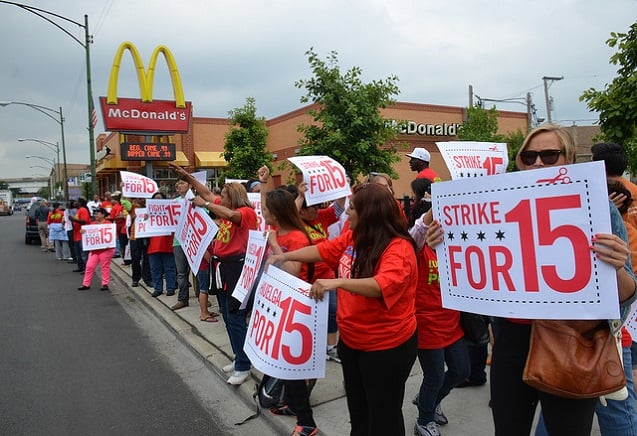
 Steve Rhodes / Flickr)” width=”637″ height=”436″ />(Photo: Steve Rhodes / Flickr).
Steve Rhodes / Flickr)” width=”637″ height=”436″ />(Photo: Steve Rhodes / Flickr).
Fast food workers went on strike last week in several major cities, including New York. The strike was a bigger version of the November 2012 fast food strikes covered by Sarah Jaffe for Truthout. Fast food workers also struck four months ago in April.
The strikers are demanding a raise from minimum wage – or close to it – to $15 an hour. The federal minimum wage is just $7.25 an hour. In New York the state minimum wage will rise to $8 an hour on January 1, 2014.
That’s still a long way from the $15 an hour demanded by striking workers. In fact, the median hourly wage among all hourly wage-earners in the country is $12.71 an hour only, according to the most recent data from the Bureau of Labor Statistics (BLS).
Is $15 an hour really a fair wage for serving fast food? Is it reasonable? Is it affordable? In a word: YES.
To read more articles by Salvatore Babones and other authors in the Public Intellectual Project, click here.
When the various US federal minimum laws were harmonized in 1978, the uniform federal minimum wage was set at $2.65 an hour. Adjusted for inflation, that is the equivalent of $9.49 today, according to the BLS online inflation calculator.
That was then; this is now. Nearly half of all Americans alive today weren’t even born in 1978. In the second decade of the 21st century, one might expect the minimum wage to be somewhat higher than it was 35 years ago.
If the minimum wage had risen in line with overall economic growth since 1978, it would now be somewhere between $13 and $18 an hour, depending on which national income data are used. The strikers’ demand of $15 sits comfortably in the middle of this range.
Fast food pay of $15 an hour would also be in line with fast food industry pay in countries like Australia, where the industry minimum of AU $17.98 an hour is equivalent to US $16.38 at current exchange rates.
Of course, in Australia fast food workers also get paid sick days, paid holidays, paid vacations and free national health insurance. Australia, incidentally, was the only major western country to avoid falling into recession during or after the global financial crisis that began in 2007.
In France the minimum wage is EUR 9.43 ($12.50) and Germany is widely expected to set a minimum wage of EUR 8.50 ($11.27). Like Australia, both countries have universal healthcare systems that cover all workers.
If $15 an hour sounds like a lot of money for serving fast food, it’s not because fast food workers are setting their sights too high. It’s because the rest of us are setting our sights too low.
For the rest of us, there has been no increase in median wages – at all – for the last 40 years (after adjusting for inflation). Economic growth has averaged about 2 percent per year, but wage growth has averaged 0 percent per year – or slightly less.
On average most Americans today make the same income that their parents did at the same point in their lives. You may make more than you did 40 years ago, but you’re now 40 years older and more experienced. Your children probably make no more than you did at their age.
If you’re a high-income professional, making the same as people did 40 years ago might not be so bad. If you’re a fast food worker, making the same as people did 40 years ago is much more challenging. The world has changed a lot in 40 years.
But can fast food restaurants afford to raise wages? To put things in context, think of the number of people in line at a fast food restaurant at lunch time.
If the first customer in line orders one adult value meal and one kids’ meal for a grand total of $8, that’s enough revenue to cover the order taker’s pay for the entire hour. Common sense suggests that counter and kitchen staff wages are almost irrelevant for a fast food restaurant.
There has been a massive debate in the US media over the impact of a $15 fast food wage on prices, sales, and employment at fast food restaurants. All of it has been theoretical. After all, there is nowhere in the United States where fast food workers make $15 an hour.
Fortunately, there are places in the world where fast food workers make $15 an hour and have excellent benefits, including vacations and health insurance. And fortunately, the Economist magazine has calculated the resulting differences in the cost of a McDonald’s Big Mac hamburger.
In Australia, the global wage leader, a Big Mac costs the equivalent of $4.94 in US Dollars – a modest increase over the $4.20 charged in the United States. That premium is mainly due to the current weakness of the US dollar. At historical exchange rates, an Australian Big Mac costs the same as an American one.
And Australia is not alone in offering cheap hamburgers despite paying workers a living wage, as Atlantic magazine associate editor Jordan Weissman points out.
In France ($3.60) and Germany ($3.53), hamburgers are actually cheaper than in the United States, despite all the benefits, regulations and unions that European employers have to deal with.
In short, the comparative evidence is pretty clear: the problem is us, the United States.
The coordinating website for the $15 living wage fast food strikes is Fast Food Forward. A fourth strike is sure to be in the cards. We could all benefit from a day without fast food. We can all afford to support fast food workers’ demands for a living wage.
Our most important fundraising appeal of the year
December is the most critical time of year for Truthout, because our nonprofit news is funded almost entirely by individual donations from readers like you. So before you navigate away, we ask that you take just a second to support Truthout with a tax-deductible donation.
This year is a little different. We are up against a far-reaching, wide-scale attack on press freedom coming from the Trump administration. 2025 was a year of frightening censorship, news industry corporate consolidation, and worsening financial conditions for progressive nonprofits across the board.
We can only resist Trump’s agenda by cultivating a strong base of support. The right-wing mediasphere is funded comfortably by billionaire owners and venture capitalist philanthropists. At Truthout, we have you.
We’ve set an ambitious target for our year-end campaign — a goal of $250,000 to keep up our fight against authoritarianism in 2026. Please take a meaningful action in this fight: make a one-time or monthly donation to Truthout before December 31. If you have the means, please dig deep.